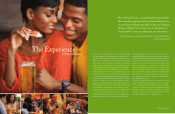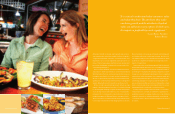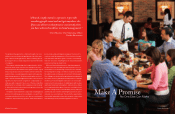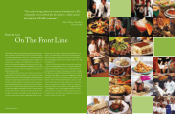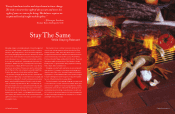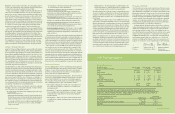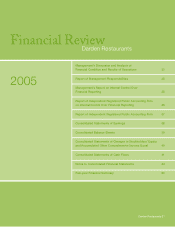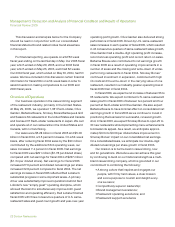Red Lobster 2005 Annual Report Download - page 4
Download and view the complete annual report
Please find page 4 of the 2005 Red Lobster annual report below. You can navigate through the pages in the report by either clicking on the pages listed below, or by using the keyword search tool below to find specific information within the annual report.
“ It is critical to understand what consumers value
and what they don’t. e attributes they value
can drive growth, and the attributes they don’t
value can add unnecessary expense. In both cases,
the impact on profitability can be significant.”
– Laurie Burns, President
Bahama Breeze
At Darden, the birth of a brand, and its growth and evolution
over many decades, reflect the insights of millions of experts –
our guests and potential customers. Consumer research is as
important to our success as ingredients and recipes are to our
menus. That’s why we always start the business development
process by identifying an underserved consumer need in the
casual dining marketplace.
Once a need is identified, we invest in additional research
and analysis to develop and introduce a new restaurant brand.
We firmly believe the more solid a new brand’s initial core posi-
tioning, the more likely it is to flourish and last for generations.
We use a sophisticated, proprietary research model that has
guided all of our internal brand development, including Olive
Garden, Bahama Breeze, Smokey Bones and Seasons 52.
After a concept is up and running, research remains an ongo-
ing part of brand management excellence. Constantly listening
to, observing and analyzing our guests and their dining experi-
ences are major factors behind the success of each Darden
restaurant. All of our restaurants conduct extensive customer
feedback programs. At Bahama Breeze, every guest check
directs customers to an Internet-based survey that asks them
to rate nearly every element of their dining experience. Smokey
Bones has relied on focus groups of frequent and former guests
as it developed its menu over the past six years. And a host of
new initiatives and processes at Red Lobster have been driven
by the most comprehensive attitude and usage study in the
brand’s 37-year history.
As pioneers in the casual dining segment, Red Lobster and
Olive Garden helped write the book on casual dining advertising
and promotion, and these efforts are also steeped in research
and testing. For example, both operating companies use a five-
step process for creating and marketing promotions. Long before
a promotional ad hits the airwaves, the companies spend up to
a year testing featured recipes in restaurants and testing the
advertising campaign in focus groups and test markets. This
process helps ensure that a promotional offering will be compel-
ling to consumers and sets up our restaurant teams for success
by preparing them to execute with consistent excellence.
In many respects, brands exist in the minds of consumers.
Their perception is our reality. So whether it is quantitative or
qualitative research, focus group feedback or a crew member’s
insightful observation, understanding what casual dining
consumers want is critical to brand management excellence
at Darden.
Darden Restaurants 54 Darden Restaurants
The Guest
It All Starts With



